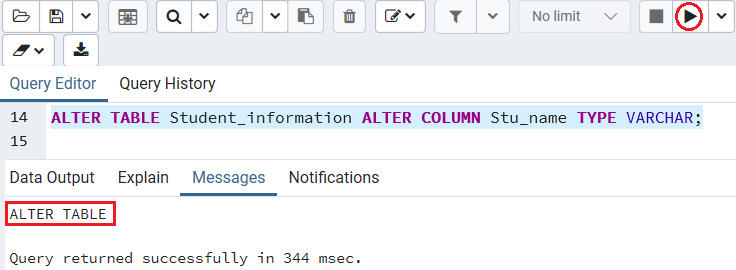
- ALTER TABLE ADD COLUMN POSTGRES UPDATE
- ALTER TABLE ADD COLUMN POSTGRES FULL
- ALTER TABLE ADD COLUMN POSTGRES PLUS
For example, to convertĪ VARCHAR(32) column named “checksum” to a TEXT column: ALTER TABLE foobar ALTER COLUMN checksum TYPE text ĪLTER TABLE foobar ADD CONSTRAINT checksum_length You may also add aĬheck constraint to a table to emulate the limit of a VARCHAR. The latter canīe thought of as an unbounded VARCHAR, or if you like, a VARCHAR(999999999999). In the Postgres world, there are few differences between the VARCHAR and TEXT data types. However,īefore you jump down there, consider a different option: abandoning VARCHAR altogether.
ALTER TABLE ADD COLUMN POSTGRES FULL
Size limit of a VARCHAR), your only option to avoid a full table rewrite is the system catalog change below. However, if you are not yet on version 9.2, or are making an operation not covered above (such as shrinking the Table rewrites are also avoided in similar cases involving the interval, timestamp, and timestamptz types. Similarly, increasing the allowable precision of a numeric column, or changing a column from constrained numeric to unconstrained numeric, no longer requires a table rewrite. Increasing the length limit for a varchar or varbit column, or removing the limit altogether, no longer requires a table rewrite. Reduce need to rebuild tables and indexes for certain ALTER TABLE … ALTER COLUMN TYPE operations (Noah Misch)* VARCHAR(64) is one of those operations! Thus, if you are lucky enough toīe using version 9.2 or higher of Postgres, you can simply run the ALTER TABLEĪnd have it return almost instantly. Will no longer require a full table rewrite. Luckily, there areįirst, some good news: as of version 9.2, there are many operations that Solution usually comes at a very high cost for large tables. (both in terms of disk I/O and wall clock time). To rewrite every single row of the table, which can be a very expensive operation If your table has a lot of data, however, this brings “access exclusive” lock which shuts everything else out of the table. This approach locks the table for as long as theĬommand takes to run. This approach works fine, but it has two huge and interrelated problems: The canonical approach is to do this: ALTER TABLE foobar ALTER COLUMN checksum TYPE VARCHAR(64) In other words, you need a column in your table to change from VARCHAR(32) to VARCHAR(64). Keccak (Keccak is pronounced “catch-ack”) (at 64 characters) VARCHAR declaration to allow more characters. The most common example of such a change is expanding a There are a few ways to accomplish this in PostgreSQL, from a straightforward ALTER COLUMN, to replacing VARCHAR with TEXT (plus a table constraint), to some advanced system catalog hacking.

One can change the data type, or more commonly, only the size limitation, e.g. When set to a positive value, ANALYZE will assume that the column contains exactly the specified number of distinct nonnull values.A common situation for database-backed applications is the need to change the attributes of a column.
ALTER TABLE ADD COLUMN POSTGRES PLUS
n_distinct affects the statistics for the table itself, while n_distinct_inherited affects the statistics gathered for the table plus its inheritance children.

Currently, the only defined per-attribute options are n_distinct and n_distinct_inherited, which override the number-of-distinct-values estimates made by subsequent ANALYZE operations. This form sets or resets per-attribute options.
ALTER TABLE ADD COLUMN POSTGRES UPDATE
SET STATISTICS acquires a SHARE UPDATE EXCLUSIVE lock. For more information on the use of statistics by the PostgreSQL query planner, refer to Section 14.2. The target can be set in the range 0 to 10000 alternatively, set it to -1 to revert to using the system default statistics target ( default_statistics_target). This form sets the per-column statistics-gathering target for subsequent ANALYZE operations. sequence_option is an option supported by ALTER SEQUENCE such as INCREMENT BY. These forms alter the sequence that underlies an existing identity column. If DROP IDENTITY IF EXISTS is specified and the column is not an identity column, no error is thrown. Like SET DEFAULT, these forms only affect the behavior of subsequent INSERT and UPDATE commands they do not cause rows already in the table to change. These forms change whether a column is an identity column or change the generation attribute of an existing identity column. RENAME CONSTRAINT constraint_name TO new_constraint_nameĪLTER TABLE ALL IN TABLESPACE name ]ĪTTACH PARTITION partition_name AS IDENTITY


 0 kommentar(er)
0 kommentar(er)
